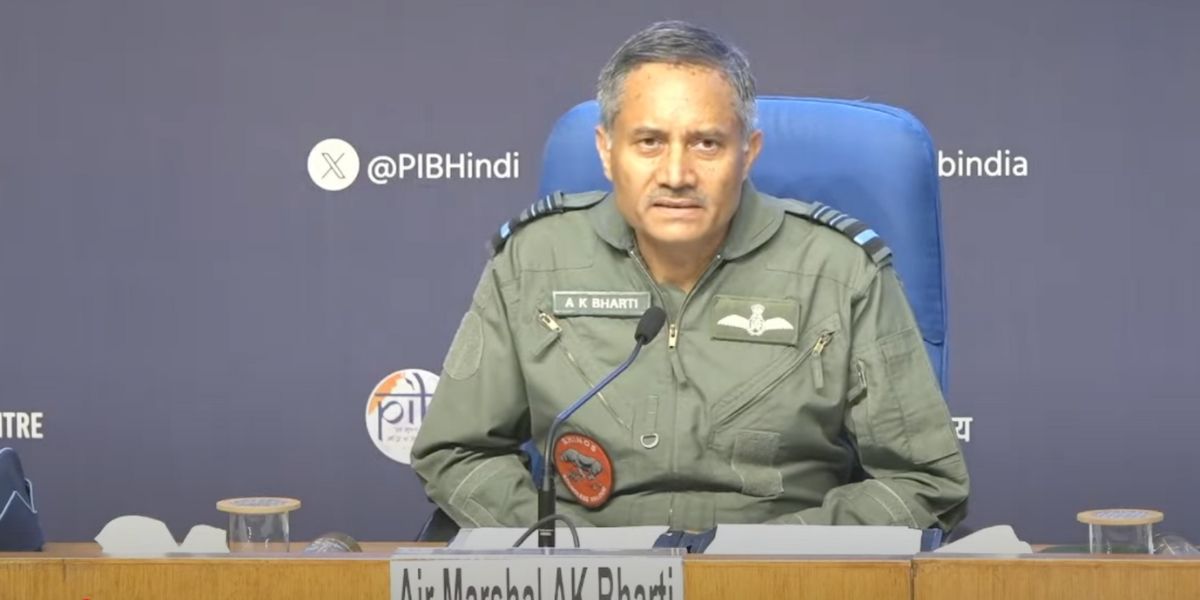Satellite imagery and strike footage presented at the briefing revealed multiple precision hits on the targeted buildings.
Published May 12, 2025 | 11:49 AM ⚊ Updated May 12, 2025 | 11:49 AM

Air Marshal AK Bharti.
Synopsis: Indian defence officials confirmed that nine terror hubs targeted during Operation Sindoor were selected as part of a broader counter-terrorism operation. The Air Force official said the strikes were designed to target only terrorist infrastructure, avoiding civilian casualties.
In a press briefing held on Sunday, 11 May, Air Marshal AK Bharti detailed how the Indian defence forces identified terrorist infrastructures in Pakistan and Pakistan-occupied Jammu and Kashmir, and how they were targeted precisely during Operation Sindoor.
Lieutenant General Rajiv Gai, who is the Director General of Military Operations (DGMO), said the strikes resulted in the elimination of over 100 terrorists, including high-value targets such as Yusf Azhar, Abdul Malik Ral, and Madhasir Ahmed, who were involved in the hijack of IC814 and the Pulwama blast.
The officials confirmed that nine terror hubs were selected as part of a broader counter-terrorism operation. Of these, the Indian Air Force (IAF) was tasked with neutralising the well-known training camps located at Muridke and Bahawalpur — sites situated deep within Pakistani territory.
They said locations were chosen after extensive target system analysis to ensure maximum impact.
“Our objective was clear: eliminate the terrorists and their infrastructure,” said Air Marshal AK Bharti during the press briefing. “The strikes were carried out using precision-guided air-to-surface munitions to avoid collateral damage. We deliberately avoided targeting Pakistani military installations.”
Satellite imagery and strike footage presented at the briefing revealed multiple precision hits on the targeted buildings. At Muridke, a sequence of four guided munitions accurately struck the training complex, destroying key facilities. In Bahawalpur, multiple structures were seen completely flattened following targeted aerial bombardment.
The targeted sites were:
The Air Force official said the strikes were designed to target only terrorist infrastructure, avoiding civilian casualties.
“Every strike was deliberate, based on real-time intelligence and high-value prioritisation. Our planning and execution were designed to make a clear distinction: we were going after terrorists, not civilians or the Pakistani military,” the official added.
However, hours after the operation, Pakistan launched a wave of unmanned aerial vehicles (UAVs) and small drones, many of which entered Indian airspace targeting both civilian areas and military installations. India’s air defense systems intercepted the majority, with minimal damage reported.
In response, Indian forces carried out a calibrated retaliatory strike that night, hitting radar installations near Lahore and a Lashkar-e-Taiba (LeT) facility near Gujranwala in the Punjab province of Pakistan.
“This asymmetric escalation from Pakistan, targeting civilians, left us with no choice,” the official said. “While we remain prepared, we continue to emphasize that our fight is against terrorism—not the Pakistani state.”
